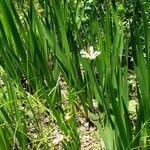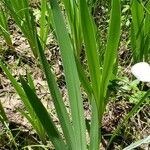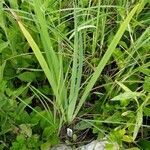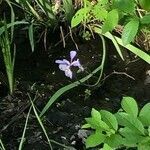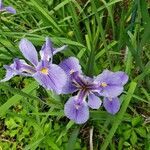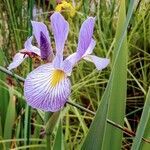Rhizomes many-branched, forming dense clumps, 2–4 cm diam., usually covered with remnants of old leaves; roots fleshy. Stems rather weak, often falling over after flowering, solid, usually 1-branched, 5–10 dm. Leaves: basal erect or often flexible, blade gray-green to bright green, buff to purplish basally, with several prominent ribs in mature leaves, linear-ensiform, 6–8 dm × 2.5–3 cm, apex acute. Inflorescence units 2–3-flowered, branch units 1–2-flowered; spathes compact, often with brown striations, ridged, unequal, outer 3–8 cm, inner 8–14 cm, firm, herbaceous. Flowers: perianth lavender to violet, rarely white; floral tube constricted above ovary, 1–2 cm; sepals spreading and arched, pale blue to purple with darker blue or purple lines, obovate to oval, 4–8.4 × 1.6–4 cm, base abruptly attenuate, claw green in median, bordered by yellow ground with blue or purple lines, yellow extending onto base of limb as finely pubescent signal patch; petals oblong-lanceolate to oblong-spatulate, 3–7 × 1–3 cm, claw greenish yellow with blue or purplish lines, apex often emarginate; ovary trigonal, 1.3–3.8 cm; style inwardly auriculate at convergences, 3–4.5 cm, crests reflexed, 0.7–2 cm; stigmas unlobed, with prominent triangular tongues, margins entire; pedicel 2.5–8 cm. Capsules ovoid, ellipsoid, or long-cylindric, trigonal or polygonal in cross section, 3–6 × 1–2 cm. Seeds in 2 rows per locule, pale brown, usually D-shaped, 5–8 mm, pitted, corky. 2n = 70, 72.
More
Plants softer than no. 9 [Iris versicolor L.]; lvs broadly linear to broadly ensiform, erect or arching; rhizomes thick, creeping, often forming extensive colonies; stem to 1 m; fls short-pediceled, 6–8 cm wide, lavender or light violet to blue-violet or purple, often dark-veined, rarely red-purple or white; sep spreading-recurved, with a bright yellow hairy blotch at the base of the blade; pet somewhat shorter than the sep; ovary 1.8–3.8 cm at anthesis; fr ovoid to ellipsoid-ovate, 4–7 cm, obtusely 3-angled, the valves strongly reflexed after dehiscence; seeds with a shallowly and irregularly pitted surface; 2n mostly = 70–72. Swamps, marshes, meadows, and ditches; coastal plain from Md. to Tex., and inland to Ont., Minn., and Okla. May–July. Var. virginica, mainly on the coastal plain, is up to 6 dm, unbranched or with a few very short branches; its frs are 4–7 cm and nearly as thick. (I. caroliniana; I. georgiana) Var. shrevei (Small) E. S. Anderson, the inland phase, is up to 1 m and more branched, usually with 1 or 2 widely spreading branches; its frs are 7–11 cm, half as thick, and the fls avg darker in shade than var. virginica. (I. shrevei)
